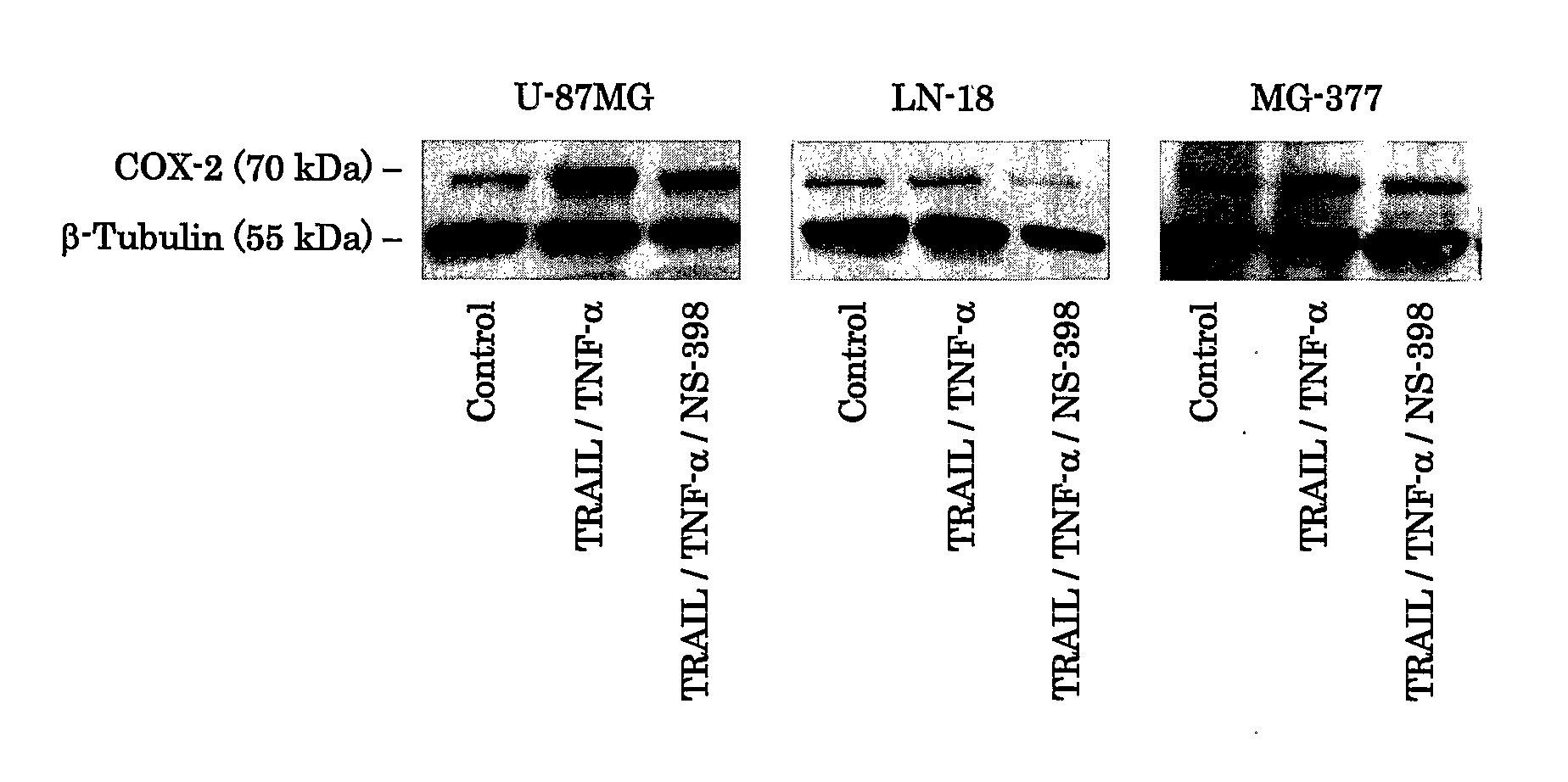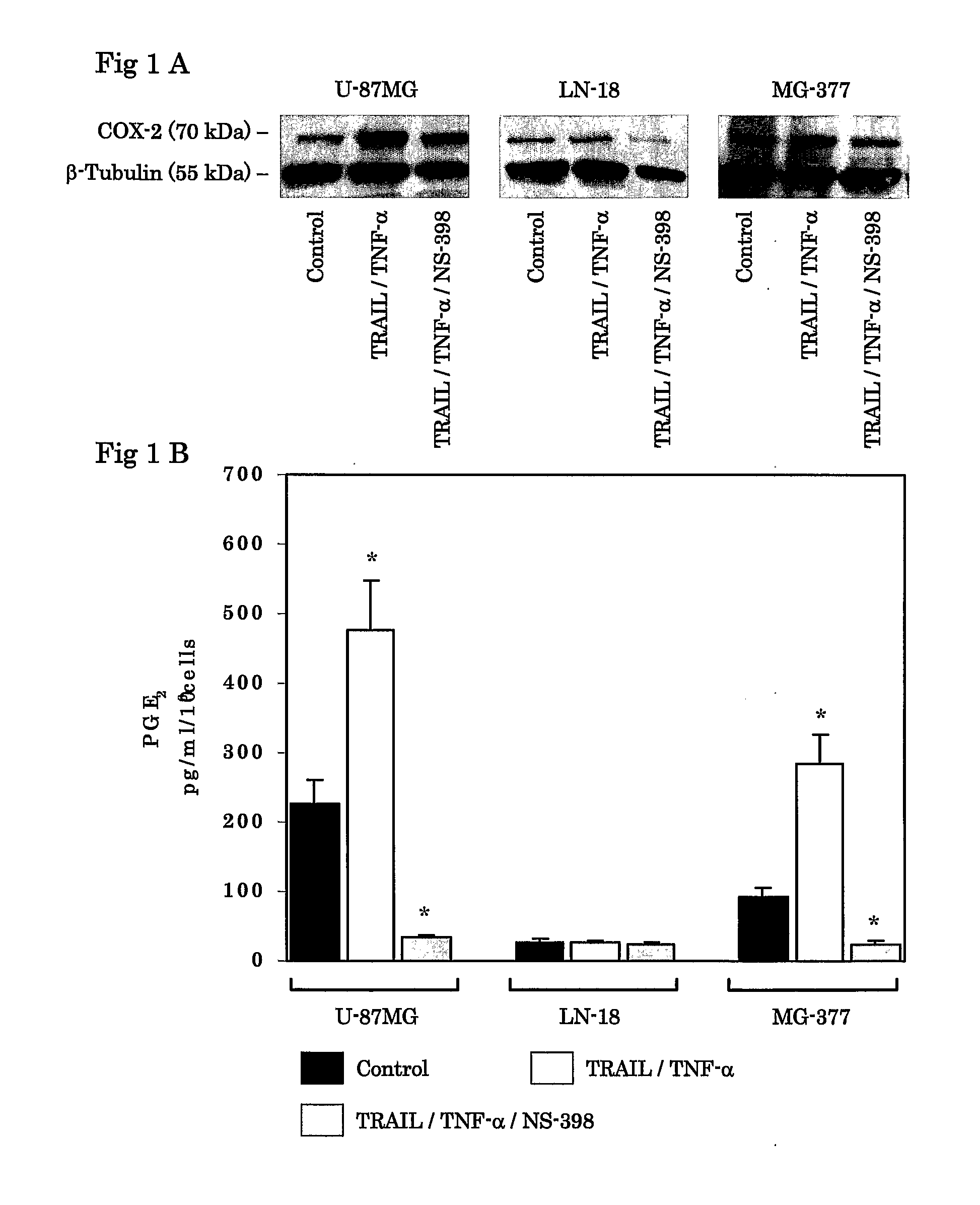Use Of Cox-2 Inhibitor to Prevent T-Cell Anergy Induced By Dendritic Cell Therapy
a dendritic cell and cox-2 technology, applied in the direction of snake antigen ingredients, drug compositions, antibody medical ingredients, etc., can solve the problems of difficult to explain the mechanism of tumor generated escape from dc-mediated immune surveillance, and the mechanism of escape is not fully understood, so as to enhance the effect of a therapeutic dc vaccin
- Summary
- Abstract
- Description
- Claims
- Application Information
AI Technical Summary
Benefits of technology
Problems solved by technology
Method used
Image
Examples
example 1
Tumor Cells, Media and Reagents
[0065]Tumor cells, including U-87MG human glioma cell line (obtained from American Type Culture Collection; Rockville, Md.), LN-18 cell line (obtained from Dr. Erwin Van Meier, Emory University; Atlanta, Ga.), and primary cultured human glioma MG-377 (obtained from surgical specimen of a glioblastoma patient at neurosurgical institute, Cedars-Sinai Medical Center; Los Angeles, Calif.), were maintained at 37° C. and 5% CO2 in Dulbecco's Modified Eagles Medium (available from Sigma; St. Louis, Mo.; hereinafter “DMEM”) supplemented with 10% heat-inactivated fetal bovine serum (available from Sigma; hereinafter “PBS”), 2 mM glutamate, 10 mM HEPES (available from Sigma), 100 U / ml penicillin (available from Sigma), 100 μg / ml streptomycin (available from Sigma). 100% di-methyl sulfonyl oxygen (available from Sigma; hereinafter “DMSO”) dissolved NS-398 (selective COX-2 inhibitor; obtained from Cayman Chemical) was used at concentrations of 10 μM. Recombinant h...
example 2
COX-2 cDNA Plasmid and Transfection
[0066]The COX-2 cDNA was isolated from the pSG5-COX-2 plasmid, which contains a full-length COX-2 cDNA in the pSG expression vector (obtained from Dr. Richard Kuhnacz, University of Texas Medical School; Houston, Tex.) by EcoRI and XbaI digestion. COX-2 expression plasmid, designated pTracer-COX-2, was constructed by inserting COX-2 cDNA between the EcoRI and XbaI sites on pTracer-CMV2 expression vector (obtained from Invitrogen), which is available to express green fluorescent protein (GFP) fused to the selectable marker Zeocin. Lipofectamine 2000 (obtained from Invitrogen) and Plus Reagent (obtained from Invitrogen) were used for transfection to LN-18 according to the manufacture's protocols. The transfected cells of pTracer-COX-2, and the empty plasmid, pTracer-CMV2, were selected by Zeocin (obtained from Invitrogen), and stable transfectants were established (LN-18-COX-2, LN-18-EP).
example 3
Detection of Apoptotic Cell Death
[0067]Tumor cells were treated with TNF-α and TRAIL for 24 hours. Apoptotic death was detected using Annexin V-FITC Apoptosis Detection Kit I (obtained from Phamingen; San Diego, Calif.). Cells were stained with Annexin V-FITC (Ann V) and propidium iodide (PI) according to the manufacture's protocol. Early stage of apoptosis was defined by Ann V+ / PI− staining as analyzed by fluorescence multicolor flow cytometry (obtained from Becton Dickinson Immunocytometry Systems; San Jose, Calif.; hereinafter “FACScan”).
PUM
| Property | Measurement | Unit |
|---|---|---|
| concentration | aaaaa | aaaaa |
| concentration | aaaaa | aaaaa |
| pH | aaaaa | aaaaa |
Abstract
Description
Claims
Application Information
 Login to View More
Login to View More - R&D
- Intellectual Property
- Life Sciences
- Materials
- Tech Scout
- Unparalleled Data Quality
- Higher Quality Content
- 60% Fewer Hallucinations
Browse by: Latest US Patents, China's latest patents, Technical Efficacy Thesaurus, Application Domain, Technology Topic, Popular Technical Reports.
© 2025 PatSnap. All rights reserved.Legal|Privacy policy|Modern Slavery Act Transparency Statement|Sitemap|About US| Contact US: help@patsnap.com



